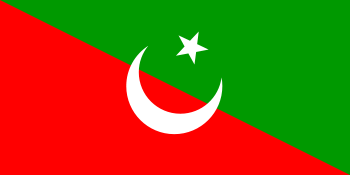All-Tatar Public Center

The All-Tatar Public Center, (ATPC, BTİÜ), also known as the Tatar Social Center (Tatar Latin: Bötentatar İctimağí Üzäge, BTİÜ; Cyrillic: Бөтентатар Иҗтимагый Үзәге, БТИҮ; Russian Всетата́рский Обще́ственный Центр, ВТОЦ) is a Tatar social organization with a nationalist agenda. The ATPC headquarters are in Kazan, Tatarstan.
History
The first congress (qorıltay) of Tatar nationalists was held in February, 1989. The newly formed organization was named the Tatar Public Center (Tatar İctimağí Üzäge). The charter and the program of the ATPC were adopted at the second congress (February, 1991). At this congress, the name of the organization was changed to the All-Union Tatar Public Center and the 35-member presidium was elected. Subsequently, after the fall of the Soviet Union, the name was changed once again to what it is now (1992).[1]
The ATPC was established by M. Mölekev (the first chairman), İ Ämixanov, Fäwziä Bäyrämeva, Z. Zäynulin, R. Safin, F. Safiullin and some others. Most of them were intellectuals from Kazan State University.[2] The current chairman is Rafis Kashapov.
In late 1980s- early 1990s, the ATPC organized many demonstrations and public meetings demanding that the government of Tatarstan proclaims the republic independent of Russia. The only time when these manifestations resulted in clashes and street fighting was on October 15, 1991 when Russian nationalists arranged a counter-demonstration which provoked a violent confrontation.[2]
In the following years, Tatarstan's government led by Mintimer Shaymiev has assumed a more adversarial position towards Moscow, which significantly weakened the ATPC's unique role as the defender of ethnic Tatars. As a result, the ATPC's popularity went down among the majority of the population while the popularity of president Shaymiev grew. Tatarstan's special status within the Russian Federation and economic concessions from Moscow achieved by Shaymiev made many demands of Tatar nationalists superfluous.[2]
In the last few years, the ATPC has not been as active as in the past. The majority of the participants in its most recent demonstrations are pensioners. The only exception is the Memorial Day (Xäter Köne) held in October of each year to commemorate the fall of Kazan. This event attracts many participants, both young and old, from all parts of Idel-Ural and is accompanied by a funeral march and Tatar rock music concerts.
In some regions of Russia, local chapters of the Tatar Public Center collaborate with local officials and concentrate mostly on cultural activities within local Tatar diasporas. However, in Bashkortostan the ATPC is playing an important political role as an opposition force against the regime of president Murtaza Rakhimov.
Functions
The main aims of the ATPC are: achieving independence for Tatarstan, establishing diplomatic relations with the Russian Federation as with foreign state, protection of the Tatar language and culture, making Tatar an only official language of Tatarstan or an official language in Russia alongside Russian. The ATPC is also striving to revive Islam in Tatarstan, to support Tatar diasporas and to protect the rights of ethnic Tatars all over the world.[1]
The main publications of the ATPC are: Taşqın (Stream), Millät (Nation) and Russian language Izvestiya TOTs (Russian: Известия ТОЦ - Proceedings of ATPC). The governing bodies of the organization are Qorıltay (Congress), Ğäli Mäcles (Plenum), Presidium (works permanently) and the chairman. Congresses: 1st - 1989, 2nd - 1991, 3rd and 4th 1993, 5th - 1996, 6th 1999, 7th -2002.[1]
According to the ATPC charter, the organization pursues its goals in an exclusively democratic way. However, some sources state that in the 1990s some ATPC leaders had contacts with the Wahhabis in Ichkeria and with the Taliban in Afghanistan. There are rumors and unsubstantiated reports about some ATPC volunteers joining the ranks of the militants in the Caucasus and Central Asia. These allegations, however, have not yet been proven. The same sources also state that the ATPC includes militarized wings İdel and Altınzan.[3]
See also
References
- 1 2 3 (Tatar) "Bötentatar İctimağí Üzäge/Бөтентатар Иҗтимагый Үзәге". Tatar Encyclopaedia. Kazan: The Republic of Tatarstan Academy of Sciences. Institution of the Tatar Encyclopaedia. 2002.
- 1 2 3 (Russian) Типы национализма, общество и политика в Татарстане
- ↑